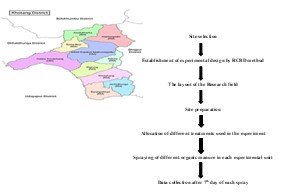Effect of different organic manures on the growth and yield of Zucchini in Khotang, Nepal
Abstract
This experiment was conducted from February 2022 to May 2022 in ward no 1 of Diktel Rupakot Majuwagadi Municipality, Khotang district of Nepal to evaluate the efficacy of different organic manures in the growth and yield of zucchini in Khotang. We aimed to identify the most effective organic manure (goat manure, poultry manure, farm yard manure (FYM), vermicompost experiment, and control), and the research was carried out in a Randomized Complete Block Design (RCBD) with five treatments and four replications. The Cheongma variety of zucchini was used as a test crop. The recommended dose of manure (goat manure at 20 t/ha, poultry manure at 15 t/ha, FYM at 20 t/ha, vermicompost at 6 t/ha, and control) was applied to each treatment. There is no significant difference observed between treatments and vegetative parameters but a significant difference was found in yield. Furthermore, results showed that the highest yield was obtained from the field treated with poultry manure (1.84 kg), followed by FYM (1.40 kg) and 1.38 kg on vermicompost, respectively. The minimum yield was recorded at 1.09 kg from control, followed by goat manure (1.29 kg). The study by (Farhan, 2021; Eifediyi, 2010) found that the application of poultry manure and FYM significantly increased fruit yield and our research study also demonstrated the same findings.
Keywords:
FYM, Organic manure, Poultry manure, Yield, ZucchiniDownloads
References
Agyarko, K. &. (2007). Survey of the use of organic manure among vegetable farmers in selected districts in Ghana. Journal of Sustainable Development in Africa, 9(4), 1-15. Retrieved from https://www.jsd-africa.com/Jsda/V9n4_Winter2007/PDF/SurveyUseOrganicManure.pdf
Dahal, G. (1992). Occurrence and epidemiology of a potyvirus‐like disease of zucchini squash in Nepal. International Journal of Pest Management, 38(2), 144-151. https://doi.org/10.1080/09670879209371672
Dhakal, K. (2014). Climate change and its impacts on crop production: A case study in Khotang district of Nepal. Master's thesis. Retrieved from http://hdl.handle.net/11250/217063
Eifediyi, E. K. (2010). Growth and yield of cucumber (Cucumis sativus L.) as influenced by farmyard manure and inorganic fertilizer. Journal of Plant Breeding and Crop Science, 2(7), 216-220. Retrieved from https://academicjournals.org/journal/JPBCS/article-full-text-pdf/61B16B33756
Farhan, M. A. (2021). Biodegradation of chlorpyrifos using isolates from contaminated agricultural soil, its kinetic studies. , 11(1),. Scientific reports, 11(1), 10320. https://doi.org/10.1038/s41598-021-88264-x
FILHO, A. C. (2020). Plot size, number of treatments and replicates and experimental precision in buckwheat. Revista Caatinga, 33(4), 1131-1139. https://doi.org/10.1590/1983-21252020v33n428rc
Gurmu, G. (2019). Soil organic matter and its role in soil health and crop productivity improvement. Forest Ecology and Management, 7(7), 475-483. Retrieved from http://www.academicresearchjournals.org/ARJASR/Index.htm
Gyawali, P. K. (2022). Need to take precedence for off seasonal vegetable farming? Issues in context of Nepal. Turkish Journal of Agriculture-Food Science and Technology, 10(12), 2495-2503. https://doi.org/10.24925/turjaf.v10i12.2495-2503.4970
Kaur, A. &. (2021). Effect of organic manures and chemical fertilizers on growth, yield and quality traits of summer squash (Cucurbita pepo L.) cv Punjab chappankaddu. International Journal of Environment and Climate Change, 11(4), 142-152. https://doi.org/10.9734/IJECC/2021/v11i430402
Kayesh, E. G. (2023). A Holistic Approach of Organic Farming in Improving the Productivity and Quality of Horticultural Crops. In Organic Fertilizers-New Advances and Applications. IntechOpen. https://doi.org/10.5772/intechopen.1001589
Larkin, R. P. (2020). Effects of selected soil amendments and mulch type on soil properties and productivity in organic vegetable production. Agronomy, 10(6), 795. https://doi.org/10.3390/agronomy10060795
Loss, A. C. (2019). Animal manure as fertilizer: changes in soil attributes, productivity and food composition. International Journal of Research Granthaalayah, 7(9), 307. https://doi.org/10.5281/zenodo.3475563
Maggio, A. D. (2013). Quality and nutritional value of vegetables from organic and conventional farming. Scientia Horticulturae, 164, 532-539. https://doi.org/10.1016/j.scienta.2013.10.005
Martínez-Valdivieso, D. F.B.A.M.C. (2017). Role of zucchini and its distinctive components in the modulation of degenerative processes: genotoxicity, anti-genotoxicity, cytotoxicity, and apoptotic effects. Nutrients, 9(7), 755. https://doi.org/10.3390/nu9070755
Minzanova, S. T. (2018). Biological activity and pharmacological application of pectic polysaccharides: A review. Polymers, 10(12), 1407. https://doi.org/10.3390/polym10121407
Mkhabela, S. N. (2020). The effects of different organic fertilizers on the vegetative growth and fruit yield of baby marrow (Cucurbita pepo L.) in Luyengo, Eswatini. International Journal of Development and Sustainability, 9, 49-67.
Mondal, B. M. (2020). Insect pests and non-insect pests of cucurbits. Stresses of cucurbits: current status and management, 47-113. https://doi.org/10.1007/978-981-15-7891-5_2
Pokluda, R. S. (2018). Vegetative, chemical status and productivity of zucchini squash (Cucurbita pepo L.) plants in responses to foliar application of pentakeep and strigolactones under NPK rates. Gesunde Pflanzen, 70(1), 21-29. https://doi.org/10.1007/s10343-017-0409-5
Rashwan, M. A. (2021). Influence of tomato waste compost ratios on plant growth and fruit quality of cucumber and summer squash. Journal of the Air & Waste Management Association, 71(9), 1067-1075. https://doi.org/10.1080/10962247.2021.1890278
Shaji, H. C. (2021). Organic fertilizers as a route to controlled release of nutrients. In Controlled release fertilizers for sustainable agriculture, 231-245. https://doi.org/10.1016/B978-0-12-819555-0.00013-3
Sharma, R. K. (2022). Nujtrient contents in different sources of organic manures of different farms in Bhaktapur district of Nepal. Journal of Agriculture and Natural Resources, 5(1), 150-156. https://orcid.org/0000-0003-1616-7633
Shrestha, S. D. (2021). Evaluation of Zucchini (Cucurbita pepo L.) Genotypes for Spring Season Production in the Mid–Hills of Nepal. Nepal Journal of Science and Technology, 20(1), 73-81. https://doi.org/10.3126/njst.v20i1.43356
Singh, M. M. (2017, November 08). Organic Farming in Chitwan District of Nepal. Springer, Singapore. https://doi.org/10.1007/978-981-10-5619-2_3
Souza, M. W. (2020). Saline-water irrigation and plant growth regulator application on zucchini fruit yield and quality. Revista Brasileira de Engenharia Agrícola e Ambiental, 24(10), 679-684. https://doi.org/10.1590/1807-1929/agriambi.v24n10p679-684
Toscano, S. B. (2021). Zucchini squash production in conventional and organic cultivation systems. Advances in Horticultural Science, 35(2), 99-213. Retrieved from http://digital.casalini.it/5002638 - Casalini id: 5002638

Published
How to Cite
Issue
Section
Copyright (c) 2024 Agriculture and Environmental Science Academy

This work is licensed under a Creative Commons Attribution-NonCommercial 4.0 International License.

